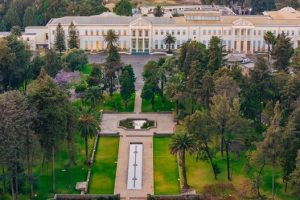Most ancient civilizations have flourished around urban areas. The same is true in Ethiopia. Blessed with incredible history and civilization, Ethiopia has magnificent urban centers which embrace invaluable heritages. Aksum, Gonder, Yeha, Lalibela, Harar, Jimma, Mekelle and Addis Ababa are among the ancient and modern urban areas that have astounding heritages.
Aksum was one of the four mightiest and prosperous ancient kingdoms. The kingdom which flourished from 100-940 AD is known by its heritages. Obelisks, coins, palaces, tombs, stone inscriptions, potteries and jewelries have been found in Aksum that manifests the greatness of the ancient empire.
However, most of these antiquities are in a danger of destruction. For instance, the obelisk of Aksum has been facing risk of collapse. Having understood the problem, the Authority for Research and Conservation of Cultural Heritages (ARCCH) has planned to renovate it in the coming August. I
The pre-Aksumite town of Yeha is another place of magnificence that has immense cultural heritages. The Temple of Yeha whose ruins are still standing pleads for an urgent renovation.
The town of Lalibela is famously known by its outstanding rock-hewn churches. But the UNESCO registered rock-hewn churches are also facing some risks. Bete Gabriel Rafael church is one of the most affected churches. In 2008 a metal roof was erected as a temporary solution to protect the cracks from further impairment. ARCCH has been striving to renovate the astonishing monolithic churches.
The fascinating city of Harar which was built between the 13th and 16th century is located in the eastern part of Ethiopia, 525 km from the capital Addis Ababa. Historical manuscripts show that it is the fourth holiest city of Islam. More importantly, it consists of deep historical and cultural inheritances. It has 82 major mosques. The UNESCO registered wall of Jugol has entitled the city as priceless beauty and historical relevance. The buildings show the unique architectural style of Ethiopians and Africans at large. The Harari State government and other stakeholders should give huge attention for preserving and promoting of the heritages.
Another historic city is Gondar. Located in the northern part of Ethiopia, Gonder had been serving as the capital of Ethiopia for many centuries. The invaluable ancient palaces, spectacular homes and impressive churches denote how much immense history and culture the city owns. The UNESCO registered fortress-city of Fasil Ghebbi is extremely marvelous which embraces Ethiopian architectural masterpiece. Hence, the Ministry of Culture and Tourism, ARCCH and other pertinent bodies should work in conserving such precious heritages of Gonder.
Addis Ababa is relatively the youngest city. It has more than 130 year history since its establishment as the capital of Ethiopia. Since then, it has passed through different stages of development. The city possesses unique architectural heritages that date back to the 19th century.
The pre-Italian, the Italian period and the post Italian architectural heritage of the city have their own unique characterizations which demonstrate its growth from small village to political and commercial capital of Ethiopia and diplomatic capital of Africa and home to other regional and international organizations.
Addis contains historic monuments, palaces, royal homes, museums, market places theatres and homes. As far as natural tourist attraction is concerned, mount Entoto has several plant and animal species. It is also playing a vital role in conserving the fauna and flora of Addis and in reducing polluting gas emissions. Addis Ababa Culture and Tourism Bureau in collaboration with other concerned bodies are diligently working to conserve, promote and develop heritages and tourist destination.
Mekelle, the capital of Tigray state and Jimma, the largest city in south west of Oromia have historic palaces and other heritages. The palaces of Emperor Yohannes IV (Mekelle) and the palace of Aba Jifar (Jimma) have huge tourism potential. The palace of Emperor Yohannes IV was renovated in recent years. On the other hand the palace of Abba Jifar II needs urgent refurbishment. Henceforth, the state government and other pertinent stakeholders have to work to restore this momentous palace.
To sum up, cultural and historical heritages of urban areas should be protected from damage, theft and other problems. Culture and tourism organizations, tour and travel agencies and other stakeholders have to work in cooperation to preserve and promote the heritages.
The Ethiopian Herald July 19, 2020
BY TSEGAY HAGOS





